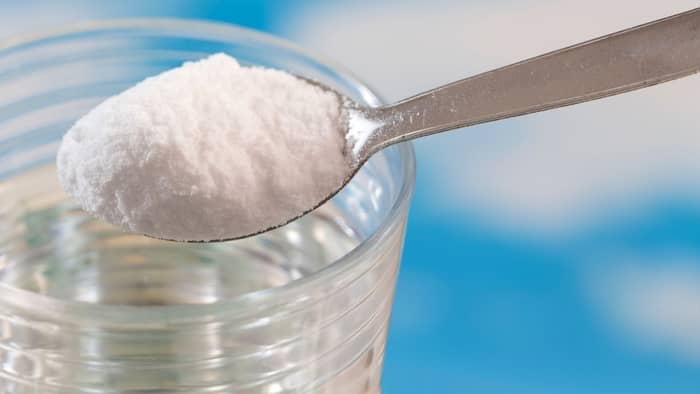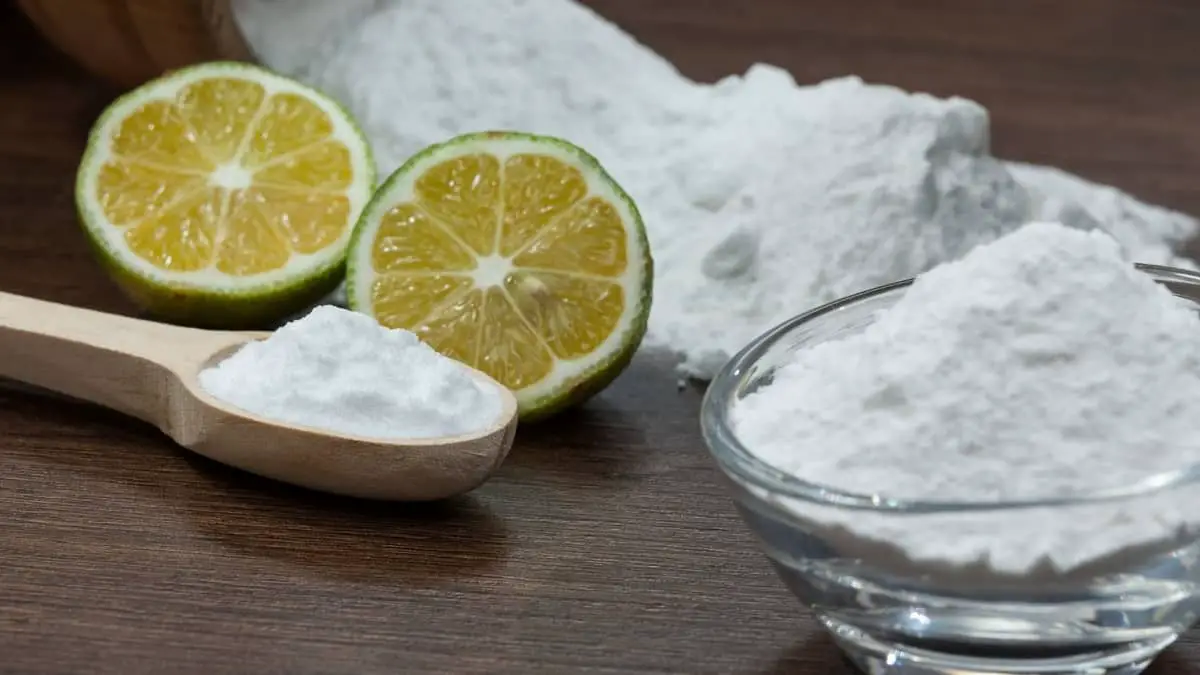Last Updated on April 27, 2022
Are you curious about sodium bicarbonate physical properties? If you are, it is best to know first that sodium bicarbonate is an everyday staple in kitchen pantries, and it is commonly known as baking soda.
Moreover, sodium bicarbonate is a carbon, sodium, hydrogen, and oxygen mixture; keep in mind that a molecule of sodium bicarbonate contains one atom of carbon, sodium, hydrogen, and three atoms of oxygen to create a molecular formula of NaHCO3 or CHNaO3.
Likewise, physical properties are characteristics that someone can observe without altering the composition or identity of the substance. For that reason, the appearance of sodium bicarbonate, such as its color, odor, taste, and state of matter, are all physical properties.
Remember, baking soda or sodium bicarbonate looks like white, crystalline powder that often forms lumps. And in general, it is odorless and tastes bitter and salty. Besides, baking soda is solid at room temperature, soluble in water, and can be separated from water through evaporation.
Sodium Bicarbonate Physical Properties
Baking soda or sodium bicarbonate’s physical and chemical properties have practical applications. The baking soda’s alkalinity causes it to react with acids, making it useful for baking, cleaning, and deodorizing.
In addition to that, acids cause many foul odors, and baking soda neutralizes these odors when it reacts to them. In most cases, the gas released during an acid-base reaction between the baking soda and acid, like lemon juice, cream of tartar, or lactic acid in buttermilk, causes your baked goods to rise.
Furthermore, the baking soda’s abrasive texture of baking soda crystals helps clean dirt stains from different surfaces, including your teeth.

Additionally, sodium bicarbonate, also known as sodium hydrogen, possessed a monoclinic crystalline structure and was produced by a French chemist named Nicolas Leblanc in 1791.
Also, Austin Church and John Dwight, bakers of New York, started the first factory that produced baking soda. You have to keep in mind that baking soda has a molecular formula of NaHCO3 and has a weak base. And overall, you commonly utilize it in baking and cooking; bear in mind that the baking soda melting point is 50 degrees Celsius or 122 degrees Fahrenheit.
Facts about sodium bicarbonate
For the most part, sodium bicarbonate is one of the commonly used leavening agents in baking; keep in mind that it is an alkaline compound that produces carbon dioxide gas when combined with an acid.
Please note that the tiny bubbles of carbon dioxide gas are trapped in the batter, which causes it to inflate or rise. Also, the common acids used for baking are vinegar, lemon juice, buttermilk, yogurt, and cream of tartar.
Not only that but also baking soda produces gas upon decomposition caused by heat. In most cases, this reaction will only occur if sodium bicarbonate is exposed to temperatures above 176 degrees Fahrenheit or 80 degrees Celsius.
Again, sodium bicarbonate or sodium hydrogen carbonate is known as baking soda. And usually, it is a crystalline white solid but is often seen as a fine powder.
Also, baking soda has a slightly salty and alkaline taste that resembles sodium carbonate or washing soda. And baking soda’s natural mineral form is nahcolite and is a component of the mineral natron that is often found dissolved in many mineral springs.
Nonetheless, sodium bicarbonate is a salt with a composition of sodium and bicarbonate ions. Its International Union of Pure and Applies Chemistry name is Sodium hydrogen carbonate and is often known as bicarb, bicarbonate of soda, or simply baking soda. And sodium bicarbonate boiling point is 851 degrees Celsius or 1563.8 degrees Fahrenheit.
What reacts with baking soda?
Are you wondering what does baking soda react with? But before that, please consider that we have used baking soda at some point in our lives.
In that regard, multipurpose and multifunctional baking soda is everywhere; you can find it in pantries, cleaning products, and recipes. Even though baking soda is valuable and well-known, many are still unfamiliar with what it can do to the extent.
EatNeat 5-Piece Airtight Glass Kitchen Canisters with Black Lids
Remember, baking soda is essential because you typically use it in many recipes as a leavening agent in baked goods. Although, it is sometimes confused with its counterpart, baking powder. Also, you use baking soda in baking as a raising agent from its name.
Besides, before the commercialization of baking soda, biological leavening and fermentation were used, but baking soda became undoubtedly helpful because of the inconvenience and extensive time associated with natural leavening.
For the most part, we have all learned from our science class and practical courses that a chemical reaction happens when a base meets an acid. This concept is similar to baking when using baking soda.
So, when you incorporate baking soda with an acid and a liquid, it will create bubbles of carbon dioxide that give baked goods a fluffy texture. Baking soda can react without an acid if it is warmed above 122 degrees Fahrenheit or subjected to long-term heat.
If you store baking soda within temperatures at or below 77 degrees Fahrenheit and 75 percent humidity, there is no denying that you can keep it for a long time.
Besides, you commonly use baking soda as an active ingredient in making quick-bake recipes like cookies, muffins, and pancakes. It is because of the fast-acting chemical reaction linked with baking soda and the acidic equivalent.
Additionally, the sources of an acid, such as buttermilk and lemon juice, combined with baking soda will define if you need to store your dough or batter inside the refrigerator or if you need to bake it immediately.
Likewise, if the acid sources are dry, like cream of tartar or cocoa powder, you can keep your batter longer when combined with baking soda. However, if your acid is wet, like yogurt, lemon juice, or buttermilk, your dough or batter needs to be used quickly.
pH of sodium bicarbonate
What is the pH of baking soda? But before that, baking soda is a substance commonly found in most kitchens. Aside from its primary role as an ingredient for cooking and baking, baking soda has many uses; you may use baking soda to clean surfaces and deodorize your refrigerator and other surfaces like carpets and beds. And baking soda, also called sodium bicarbonate, has a pH of 9, making it a mild alkaline substance.

The pH or potential of hydrogen of a substance is a measure of acidity and alkalinity. The scale ranges from negative 1 to 15. The low values indicate acidic, and the high values indicate alkaline.
Remember, pure water possesses a neutral pH value of 7. weak acid, also known as base solutions, possesses a pH closer to 7. Not only that but also strong acids and alkalis have a pH near the extreme values of negative 1 and 15.
Moreover, strong acids and alkalis also give more hazards than weak acids, although exceptions exist. For instance, a strong solution of sulfuric acid can dissolve steel. Thus, phosphoric acid found in carbonated soft drinks is safe to consume in small amounts. Considering that the baking soda has a pH of 9, this makes it a weak alkaline substance.
FAQs
What Is The pH Of Baking Soda?
Essentially, baking soda is a mild alkaline substance since it possesses a pH of 9. And for that reason, sodium bicarbonate is a weak alkaline substance.
What Does Baking Soda React With?
Whenever you mix your baking soda with an acid, it will produce bubbles of carbon dioxide that provide baked goods with a fluffy texture.

Zarah is an experienced pastry chef whose creations have delighted countless customers. With a passion for baking, Zarah has developed a unique style that combines classic techniques with modern flavors. Her desserts are consistently crafted with the finest ingredients, and her attention to detail is evident in the stunning and delectable results. Zarah has a wealth of experience in the pastry kitchen, and loves to share her knowledge with others. Whether it is teaching a class or creating a custom cake for a special occasion, Zarah is committed to making sure every customer is satisfied.


